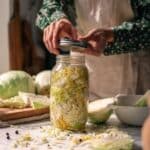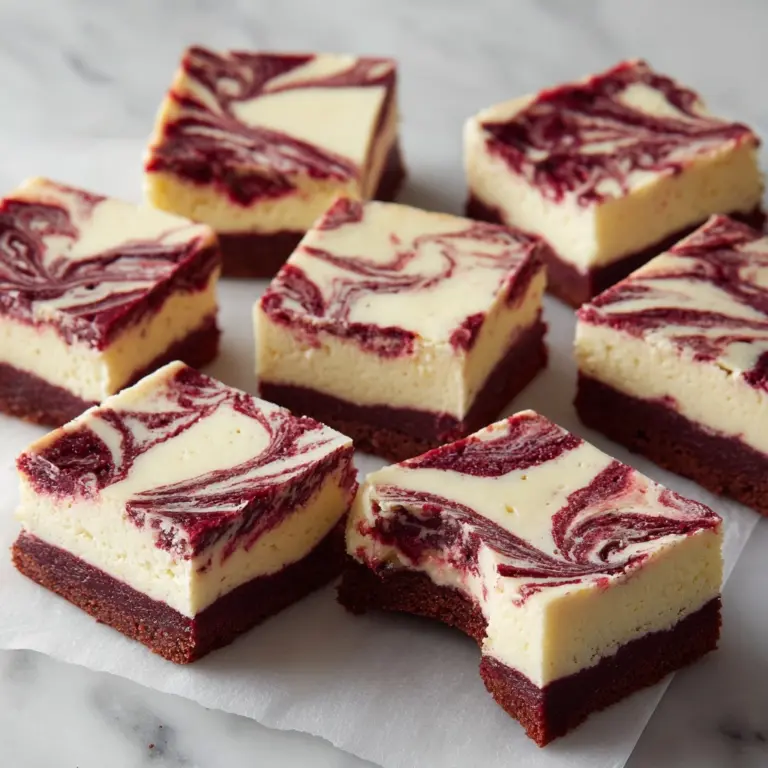Roasted Garlic Sauerkraut Recipe
Introduction
Roasted Garlic Sauerkraut brings a delicious twist to traditional sauerkraut with the deep, mellow flavor of roasted garlic. This easy fermentation recipe results in tangy, crunchy cabbage with a subtle sweetness from the roasted cloves. It’s perfect as a side dish or a flavorful addition to sandwiches and salads.

Ingredients
- 500 grams cabbage, chopped
- 50 grams garlic, roasted
- 1 teaspoon black pepper
- 200 grams water
- 20 grams sea salt
Instructions
- Step 1: To roast the garlic, cut a whole garlic bulb in half, leaving the skin on. Place it cut-side down on a parchment-paper-lined pan (no oil) and roast at 400°F for 30 minutes. Let it cool, then squeeze the cloves out; some may be soft and mushy, which is fine. Alternatively, dry roast peeled garlic cloves.
- Step 2: Wash your fermentation equipment, including the jar, weight, and lid, thoroughly.
- Step 3: Remove the outer leaves of the cabbage and rinse lightly with cool water.
- Step 4: Chop the cabbage to your preferred thickness.
- Step 5: Using a kitchen scale, measure out all ingredients.
- Step 6: In a large bowl, mix the chopped cabbage, roasted garlic, black pepper, sea salt, and water. Lightly massage the cabbage to break up any large pieces.
- Step 7: Pack the mixture, including the brine, into a clean 32-ounce jar.
- Step 8: Place a fermentation weight in the jar to fully submerge the cabbage and keep it under the liquid. If liquid is insufficient, press the weight down and wait up to 12 hours for the cabbage to release more brine.
- Step 9: Secure the lid loosely to allow gases to escape. If possible, use a rust-proof lid. Place the jar in a dish to catch any spills.
- Step 10: In the first few days, the mixture should become bubbly. “Burp” the jar by loosening the lid briefly to release built-up gas. Clean the lid and adjust the fermentation weight as needed to keep the cabbage submerged.
- Step 11: Ferment the sauerkraut at room temperature for 21 to 28 days.
- Step 12: After fermentation, remove the weight, seal the jar tightly, and refrigerate to slow further fermentation and preserve the sauerkraut.
Tips & Variations
- Use organic cabbage and garlic for the best flavor and fermentation results.
- Add caraway seeds or juniper berries for a unique flavor twist.
- If you prefer milder garlic flavor, roast the garlic for less time or reduce the quantity.
- Make sure the cabbage stays submerged to prevent mold; use a clean fermentation weight and press down daily if needed.
Storage
Store the fermented sauerkraut in the refrigerator in a sealed jar for up to 3 months. The flavor will continue to develop over time. Serve cold or at room temperature. If you want to soften it slightly before serving, you can briefly sauté or warm it in a pan.
How to Serve

Serve this delicious recipe with your favorite sides.
FAQs
Can I use peeled garlic instead of roasting a whole bulb?
Yes, you can dry roast peeled garlic cloves instead of roasting the whole bulb. This will still add a roasted garlic flavor, though it may be slightly less mellow.
What if my sauerkraut isn’t bubbling during fermentation?
Some fermentations take longer to show bubbles. Make sure the cabbage is fully submerged, the jar is sealed properly (but not too tight), and that it’s kept at room temperature. Patience is key; it should ferment within a few days to a week.
Print
Roasted Garlic Sauerkraut Recipe
- Total Time: 21 days 50 minutes
- Yield: Approximately 3 cups of sauerkraut 1x
- Diet: Vegan
Description
This Roasted Garlic Sauerkraut recipe offers a flavorful twist on traditional fermented cabbage by incorporating roasted garlic for a rich, mellow taste. Combining the natural tang of sauerkraut with the sweetness of roasted garlic creates a unique condiment perfect for enhancing sandwiches, salads, and more. This recipe walks you through roasting garlic without oil, prepping cabbage, and fermenting the mixture properly to develop delicious probiotics.
Ingredients
Vegetables
- 500 grams cabbage, chopped
- 50 grams garlic, roasted
Seasonings and Liquids
- 1 teaspoon black pepper
- 200 grams water
- 20 grams sea salt
Instructions
- Roast the garlic: Cut a whole garlic bulb in half while still unpeeled, place face down on a parchment-lined baking pan without oil, and roast at 400°F (204°C) for 30 minutes. Let cool before squeezing out the cloves, which will be soft and can vary in texture.
- Clean fermentation tools: Thoroughly wash your fermentation jar, weight, and lid to prevent unwanted bacteria from spoiling your sauerkraut.
- Prep the cabbage: Remove the outer leaves from the cabbage, rinse lightly under cool water, and chop to your desired thickness for optimal fermentation.
- Measure ingredients: Use a kitchen scale to precisely measure all ingredients to ensure correct salt and water balance for safe fermentation.
- Mix ingredients: In a large bowl, combine chopped cabbage, roasted garlic, black pepper, sea salt, and water. Lightly massage the cabbage to start releasing juices and break down any large pieces.
- Pack the jar: Place the mixture and all liquid into a clean 32-ounce fermentation jar, pressing down firmly to remove air pockets.
- Submerge with weight: Insert a fermentation weight to fully submerge cabbage under the brine. If there is insufficient liquid, press down with the weight to encourage more liquid release over the next 12 hours.
- Secure the lid: Place a rust-proof lid on the jar, securing it loosely enough to allow gases to escape during fermentation. Optionally place the jar on a dish to catch any overflow.
- Burp the jar as needed: During the first few days, sauerkraut will become bubbly. Open the jar briefly to release gas buildup (burp), clean the lid, and press down the weight if it rises above the brine.
- Ferment: Keep the jar at room temperature for 21-28 days to allow the flavors to develop and beneficial bacteria to proliferate.
- Refrigerate: After fermentation, remove the weight and store the sauerkraut in the refrigerator to slow fermentation and preserve flavor.
- Enjoy and review: If you love this recipe, consider leaving a five-star review to support the community.
Notes
- Use a rust-proof lid to avoid contamination from metal corrosion.
- Ensure the cabbage is completely submerged under the brine to prevent mold growth.
- Fermentation time can vary depending on ambient temperature and desired tanginess.
- Roasting garlic imparts a sweeter, mellower flavor compared to raw garlic in traditional sauerkraut.
- Burp the jar regularly in the early days to prevent excessive gas pressure build-up.
- Use a glass fermentation weight or similar to keep cabbage submerged without introducing contaminants.
- Prep Time: 20 minutes
- Cook Time: 30 minutes
- Category: Fermented Condiment
- Method: Fermentation
- Cuisine: German
Keywords: sauerkraut, roasted garlic, fermented cabbage, probiotic food, fermented condiment, fermented vegetables, garlic sauerkraut, homemade sauerkraut







